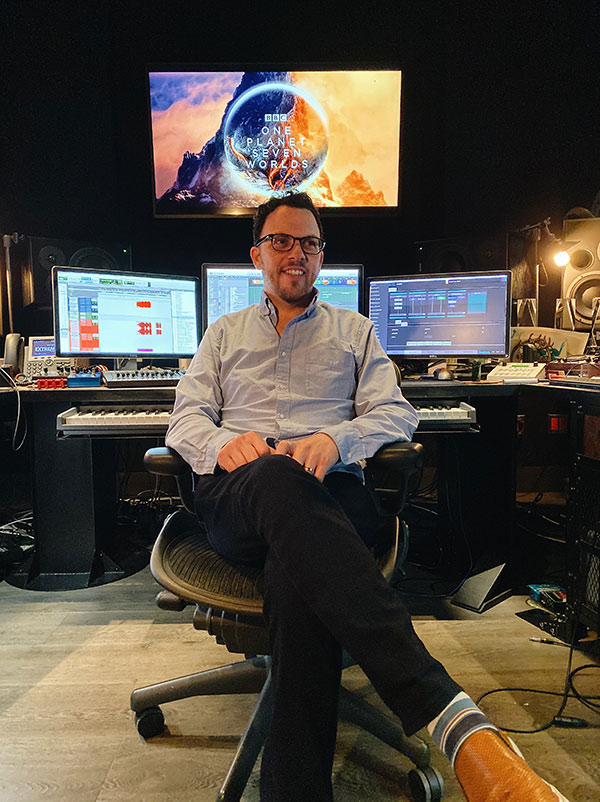“The H9000 is just so deep, and so thoughtful, in terms of the way that these effect algorithms are built. I've had it for a year now and I feel like I haven't scratched the surace,” says Shea, who integrated the processor into his studio at Zimmer’s multi-room Remote Control complex in Santa Monica, California, where he has worked for the past 12 years. Bleeding Fingers, a composer collective based at the facility, was launched by Zimmer with business partner Steve Kofsky and Extreme Music’s Russell Emanuel in 2013 to provide custom music to television and film projects.
Shea opted for the H9000R, a version of the 2RU processor unit with no front panel controls that mounts in a machine room or other remote location. Control of all the settings and parameters is handled by Emote, which is available as a standalone Mac and Windows application and as an AAX, AU and VST plug-in. When instantiated as a plug-in, all of Emote’s parameters may be automated within the DAW session. “I use a two-screen system; one screen has Logic and the other has Emote in full view. So the chains of effects are all editable on the screen next to my main workspace,” he says.
The H9000 is loaded with 1600 unique algorithms from Eventide’s H8000 and H9 processors with over 500 presets offering a menu of reverb, delay, modulation, pitch shifting, distortion and other settings. The unit introduces a new paradigm, FX Chains, that allows the user to connect any set of four effects, with flexible routing, to create a channel strip, guitar pedalboard or other processing combination.
Shea, who is a guitarist, continues, “What I enjoyed doing when I first got it was just building weird chains of stuff. I did one where it went to the SP2016 [reverb], then the Q-Wah, then the Reverse thing, to make it all psychedelic, and then the TremoloPan, to get some modulation in there. You could spend three hours just messing with this stuff, which is the joy of it.”
Offering another example, he says that with the Synthlike Filter algorithm “You can use it as a high pass and a low pass filter and really sculpt where you want the effect to be ‘speaking.’ It's little things like that that you can insert in this chain of four that all of a sudden makes something super extreme [into something] a lot more usable or a lot more subtle. You can have this crazy chain, and because you are able to superimpose some of these more utility-style building blocks, it's just awesome.”

Shea has been particularly inspired by the reverb algorithms in the H9000, he says. Multi-channel algorithms available in the unit include 5.1 halls, chambers, plates, rooms, booths and various ambient spaces. Shea uses a Session preset loaded with eight reverb algorithms including halls, rooms, plates, Blackhole and Shimmer (Sessions are the top level in the H9000 software control hierarchy; a Session saves the entire state of the hardware and software at a given moment). “A lot of times, when I was working on an emotional piano and strings piece, those H9000 algorithms beat out anything that I had in-the-box. I feel like you can get these very long tails that don't make the drive signal feel like it's not defined. Anyone that's walked in the room has said, ‘How the hell did you get that reverb to sound so good?’"
Shea began using Eventide plug-ins long before adding the H9000 and says that one of his favorites is still the SP2016 Stereo Room. “I use that all over,” he says, typically to reposition a close-miked source in a larger space. “It feels like you recorded it in a more expansive place than where you actually recorded it. Alan Meyerson hipped me to that process on Planet Earth II, when he mixed the score for that series. I've been using it that way ever since, and it's tremendous.”
As a composer, Shea says that he really appreciates the musicality of the H9000, which enables him to beef up the sound of an instrument harmoniously. “Each pitch can have its own settings, and its own time with which it's to speak; you can pick the scale for each thing,” he explains. “You can make it so much more musical than an off-the-shelf pitch thing, where you wind up doing endless passes of automation in Logic to force it to be musical” — because it isn’t a musical tool but rather a utilitarian effect.
“So it was a breath of fresh air when I pulled up the pitch shifting algorithms. I can just focus on my idea as a composer and not have to worry about a wrong note jumping out and taking me out of it, and making me try and solve a problem that doesn't have anything to do with the creative ideas that I'm focusing on. It has made playing with the thickening of harmonics really effortless.”
Over 1,500 people worked on the seven-part Seven Worlds, One Planet, which involved more than 90 shoots in 41 countries. Of the three BBC Natural History Unit series to feature music by Bleeding Fingers, “I've been a composer,” says Shea. “I was lucky enough to be paired with some amazing composers on those projects. This one was the first one where I had a more omnipresent role in the music, save for Anže Rozman, who helped me write a couple of cues.” Shea also co-wrote the main theme for this latest series with Zimmer. The series debuted October 2019 in the U.K. and is narrated and presented by naturalist Sir David Attenborough. It debuted on multiple outlets in the U.S. in late January 2020.
